Freight Container
Containerized freight in Japan travels in a variety of smaller domestic containers, as well as the international standard 20 and 40-foot (the 20’ is also known as the ISO 1-unit and the 40’ as the ISO 2-unit) containers. All Japanese container flat cars are single-level, due to the restricted clearances and car weight limits of Japanese railways (and probably for stability reasons on narrow-gauge track). While they may be stacked for storage, they are never stacked for transportation (with the exception of empty transport of some low-sided models), and lack the top-corner anchor points found on ISO containers (which are stacked for transportation elsewhere than Japan). This also prevents them from being lifted by overhead cranes of the type used for ISO containers, and the usual lifting method is via forklift; the base of each container has holes for the “forks” to permit stable lifting by a forklift.
Most container flat cars are rated for 95 kph, but newer models are rated for 100 or 110 kph.
Some electrified lines specify a maximum container height of 2.6m, which prevents loading of “tall” containers unless special cars are used.
Note: all dimensions are metric unless noted. A peculiarity of Japanese domestic containers is that their size is described in feet of length, while all other dimensions are in the more usual (for Japan and most of the world) metric system of measurements. Weight and capacity are in metric tons (1,000 kg).
The specialty flat cars used for containers are described in the KOKI section of the Freight Cars page.
Container Identification
Japanese domestic containers are identified by the combination of model number (e.g., “19D”) and a five or six-digit serial number. Serial numbers are reused between container models, so the number alone is not unique. When a two-digit number appears in the model designation, it typically refers to the volume of the container in cubic meters.
International containers are identified by an ISO 6346 identifier, which consists of a four-character owner code that always ends in “U”, and a seven-digit number (six real digits plus a check digit). This letter/number combination is unique worldwide. There are, however, some “shipper owned” containers that do not follow this convention, and thus may not have a way of uniquely identifying a specific container.
For Japanese domestic containers, in the model designation, several prefix letters have special meaning:
First letter:
U = Private Owner
Z = Special (or perhaps unique)
Second letter (or first for JRF-owned containers):
F = Refrigerated (the difference from “R” is unclear, perhaps “F” means “frozen”)
M = Mugai (“open”), meaning an open-topped container or a low container with top doors
R = Refrigerated
T = Tank (for liquid or liquified gas)
V = Ventilated (for transport of produce and similar)
Specialty Containers
The prefix “Z” appears to denote special-purpose containers (perhaps unique).
ZG: I’m aware of three of these, the ZGZ-101, ZG-1 and ZG-3. All appear to be electrical generators in container form (the “G” apparently denoting generator). The ZG-3 was used to power refrigerated containers on an express freight: the Cool Express.
ZX45A: a container used to perform performance evaluations on a locomotive.
Z54A: see the description of the U54A in the 30-foot container section below for details.
ZX17A: this is used for practicing loading of containers (presumably for operator training).
Common Sizes
This is not a complete list. A number of models exist that don’t have entries in wikipedia, and I’ve only listed here the major ones of those that do have entries. These are likely limited-production ones for a specific purpose. When searching for one, googling for the string “JR 貨物 形コンテナ” (which translates roughly as “JR Freight Container Shape”) along with the model number (e.g., “U20A”) may locate information in Japanese.
10-foot (domestic)
Uncommon, but still in use as of 2001.
The 11-foot (but usually called “10 foot”) “C” series were older models, introduced starting in 1966. At least some of them survived into JRF use.
C10: height 2,356mm (7’ 9”), width 2,372mm (7’ 9”), length 3,301mm (10’ 10”)
These were painted green and had a door on one side.
Max loading 5 tons. Wt: 1t. Capacity 14.3 cubic meters.
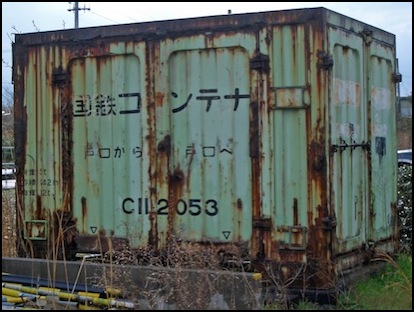
JNR C11 (2008)
Photographer: Flow in edgewise
C11: height 2,356mm (7’ 9”), width 2,392 mm (7’ 10”), length 3,301 mm (10’ 10”)
These were painted green, and had doors on three sides.
Max loading 5 tons. Wt: 1.2t. Capacity 14.3 cubic meters.
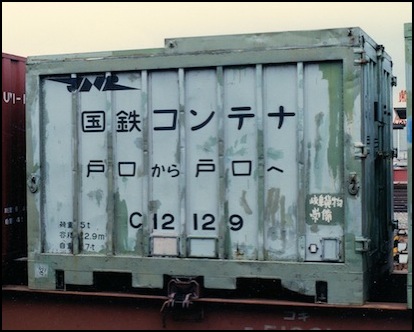
JNR C12 (1987)
Photographer: spaceaero02
C12: height 2,356mm (7’ 9”), width 2,370 mm (7’ 9”), length 3,300 mm (10’ 10”)
These were painted green, and had doors on one side and the ability to open part of the roof.
Max loading 5 tons. Wt: 1.7t. Capacity 12.9 cubic meters.
U20A - a “tall” container (20 m3?)
12-foot C-series (domestic)
The 12-foot C-series of containers was the dominant form during the JNR era, and some models persist in use to the present, although they have largely been replaced by the later 19 series.
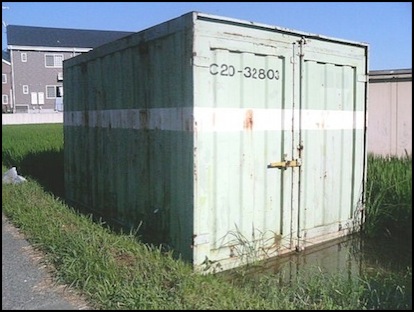
C20 Container (2006)
Photographer: Muyo
C20: height 2,350mm (7’ 9”), width 2,438 mm (8’), length 3,658 mm (12’)
Introduced in 1971, this was a forerunner of the modern JR “19” series container. It was painted green with a horizontal white stripe. There was a door on one side. Use of these containers was apparently discontinued in 2008, replaced by the 19D.
Max loading 5 tons. Wt: 1.1t. Capacity 17.0 cubic meters.
C21: height 2,350mm (7’ 9”), width 2,438 mm (8’), length 3,658 mm (12’)
Introduced in 1974, it was painted green with a horizontal blue stripe. There was a door on one side. This model had lifting fittings on the top four corners. Use of these containers was apparently discontinued in 2006, replaced by the 19D.
Max loading 5 tons. Wt: 1.3t. Capacity 17.0 cubic meters.
C30: height 2,350mm (7’ 9”), width 2,438 mm (8’), length 3,658 mm (12’)
Introduced in 1983, it was painted green with a horizontal red stripe. There were doors on three(?) sides, one of which had a restricted range of motion due to the corner fittings. This model had lifting fittings on the top four corners. Use of these containers was apparently discontinued in 2004, replaced by the 19G.
Max loading 5 tons. Wt: 1.4t. Capacity 16.5 cubic meters.
C31: height 2,350mm (7’ 9”), width 2,438 mm (8’), length 3,658 mm (12’)
Introduced in 1983, it was painted green with a horizontal red stripe. There was a door on one side. It is unclear if this model had lifting fittings on the top four corners, but unlike the C30 there was no restriction on the opening of the door. Use of these containers was apparently discontinued in 2009, replaced by the 19G.
Max loading 5 tons. Wt: 1.4t. Capacity 17.0 cubic meters.
C35: height 2,438mm (8’), width 2,438 mm (8’), length 3,658 mm (12’)
Introduced in 1984. This model may have had multiple doors, but was not fitted with a wooden floor (which had been used on some other models). Use of these containers was apparently discontinued in January of 2010.
Max loading 5 tons. Wt: 1.4t. Capacity 17.2 cubic meters.
C36: height 2,438mm (8’), width 2,438 mm (8’), length 3,658 mm (12’)
Introduced in 1984. This model may have had multiple doors, and was not fitted with a wooden floor. It was said to be “relatively common”. Some of these containers may still be in use. Said to be identical to the C35 except for the interior. One online picture shows a blue color for the container, but color is not described on the Wikipedia page.
Max loading 5 tons. Wt: 1.4t. Capacity 17.1 cubic meters.
C40: height 2,500mm (8’ 2”), width 2,438 mm (8’), length 3,658 mm (12’)
Introduced in 1987 as an improvement on the C35, but only a small number were produced before JRF began production of the 18A. Use of these containers was apparently discontinued in 2007. These were painted blue with a white horizontal band. The dimensions of this container were carried forward for the newer containers.
Max loading 5 tons. Wt: 1.4t. Capacity 17.9 cubic meters.
C95: height 2,438mm (8’), width 2,438 mm (8’), length 3,658 mm (12’)
Introduced in 1978, this was an insulated “cold storage” container. Use of these containers was apparently discontinued in 2006 when privately-owned and/or refrigerated containers became the norm. These were painted blue and white in a horizontal four-stripe pattern.
Max loading 5 tons. Wt: 1.8t. Capacity 15.0 cubic meters.
NC1: Apparently originally used by Nippon Express, many of these were transferred to JR Freight.
These were painted blue with a diagonal yellow stripe.
These appear to have been 12-foot, 5 ton containers, but Wikipedia lacks detailed stats for them.
ZC1: Apparently originally owned by National Express, and said to be “based on” the C35/C36, but “smallish” compared to either those or the C20 (ambiguity in the machine translation of the wikipedia page).
These appear to have been 12-foot, 5 ton containers, but Wikipedia lacks detailed stats for them.
12-foot 18 Series (domestic)
The “18” series were the first containers introduced after JR Freight was formed in 1987.
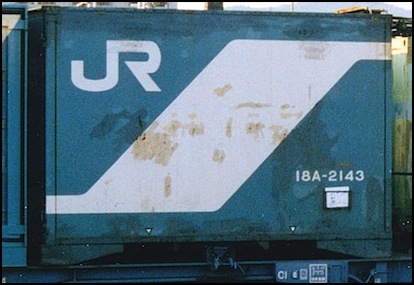
JRF 18A (1990)
Photographer: spaceaero02
18A: height 2,500mm (8’ 2”), width 2,438 mm (8’), length 3,658 mm (12’) (dimensions unconfirmed)
Introduced in 1987 and based on the C40 design. Use of these containers was apparently discontinued in January of 2010. These were painted “cream and blue”, apparently with a solid stripe.
Max loading 5 tons. Wt: 1.4t. Capacity 18 cubic meters. (per Wikipedia, but I’d guess it’s really 17.9)
18B: height 2,500mm (8’ 2”), width 2,438 mm (8’), length 3,658 mm (12’)
Introduced in 1988. Use of these containers was apparently discontinued in 2001. This model apparently had doors on both sides. These appear to have been painted “cream and blue”. This may have been a special model for use in Tōkyō.
Max loading 5 tons. Wt: 1.4t. Capacity 17.9 cubic meters.
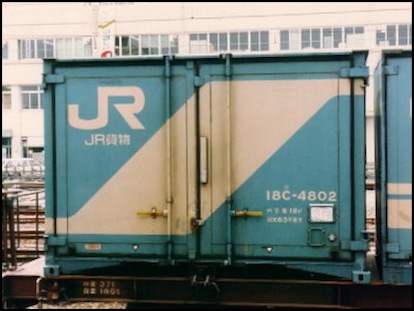
JRF 18C at Soga (date unknown)
Photographer: Yamato-i
18C: height 2,500mm (8’ 2”), width 2,438 mm (8’), length 3,658 mm (12’)
Introduced in 1988. These containers appear to have still been in use as of 2008. This model apparently had doors on both sides. Described as having been painted “cream and blue”, pictures show a blue color with a wide diagonal cream stripe identical to the 18A. Interior space was expanded by lowering the floor. There’s a reference to a length of 3,715mm, but it also gives the 3,658mm size, so it’s unclear if this was also longer.
Max loading 5 tons. Wt: 1.4t. Capacity 18.1 cubic meters.
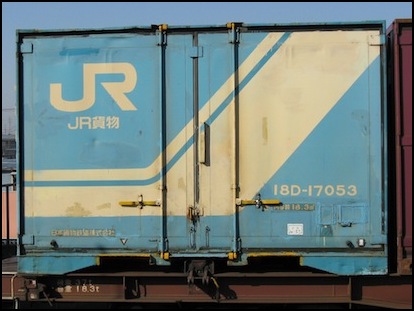
JRF 18D (2008)
Photographer: はやたま (Fast ball)
18D: height 2,500mm (8’ 2”), width 2,438 mm (8’), length 3,715 mm (12’ 2”)
Introduced in 1988 and produced in substantial numbers (“about” 23,600). These containers appear to have still been in use as of 2009. These are painted similar to the 18A except for the stripe, with a wide diagonal cream double-stripe that goes up to the top, but does not reach the bottom, instead turning horizontal.
Max loading 5 tons. Wt: (not stated). Capacity 18.3 cubic meters.
18E: (dimensions not stated)
This was a prototype of a vibration reducing model. The U18A FF “Floating Floor” design is similar.
12-foot 19 Series (domestic)
The “19” series container has an interior dimension of approximately 19 cubic meters, and the standard model has a capacity of 5 tons (metric tons, 5,000 kg). Several varieties exist, identified by different letter suffixes, and apparently sometimes by a prefix (the “V19B” appears to be a ventilated model by one photo, and I’ve seen that term applied to it on Japanese sites). The 19D appears to be the most common version.
19A: height 2,500mm (8’ 2”), width 2,500mm (8’ 2”), length 3,715 mm (12’ 2”)
Introduced in 1992. These containers appear to have still been in use as of 2009. The extra width proved a problem when loaded on trucks, and production of this model was limited as a result. The paint scheme was a dark red top and black lower third, with a cream horizontal diamond below the JRF logo.
Max loading 5 tons. Wt: (not stated). Capacity 19.0 cubic meters.
19B: height 2,500mm (8’ 2”), width 2,450mm (8’), length 3,715 mm (12’ 2”)
Introduced in 1994. These containers appear to have still been in use as of 2009. The initial paint scheme was a similar to the 19A but without the black lower third; later a second paint scheme using the small JR logo without the white diamond was used, and possibly others (Wikipedia seems to suggest it varied by manufacturer and date). Reconditioned models have an “R” suffixed to the serial number. These are all scheduled to be replaced by 2012.
Max loading 5 tons. Wt: 1.5t. Capacity 18.7 cubic meters.
19C: height 2,500mm (8’ 2”), width 2,450mm (8’), length 3,715 mm (12’ 2”)
Introduced in 1996. These containers appear to have still been in use as of 2009. The initial paint scheme was a similar to the 19B.
Max loading 5 tons. Wt: 1.5t. Capacity 18.5 cubic meters.
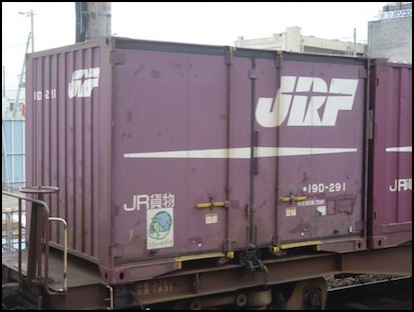
JRF 19D at Chiba Station (2008)
Photographer: Yamato-i
19D: height 2,500mm (8’ 2”), width 2,450mm (8’), length 3,715 mm (12’ 2”) (Wikipedia info)
As of 2009, 28,466 of these were in use. The initial paint scheme was a similar to the 19B. The 19D is equipped with a “corner bracket for easy shipping”, which in photos appear to be the usual ISO-style top and bottom corner brackets.
Max loading 5 tons. Wt: 1.5t. Capacity 18.5 cubic meters.
19D, 5-ton (interior 18.68m3) (U.S. Govt. website info)
Maximum Loading Capacity: 5,000 kg (approx. 11,023 lbs),
Gross Weight: 6,400 kg (approx. 14,109 lbs),
Dimensions:
(exterior): Length 3,715 mm (12' 2"), Width 2,450 mm (8’), Height 2,500 mm (approx. 8'2")
(interior): Length 3,647 mm (12'), Width 2,275 mm (7' 6"), Height 2.252 mm (approx. 7' 5")
other versions (seen or referenced in print):
18B, 19B (18.5? m3), 19F (18.8m3), 19G (18.8m3)
ventilated models: V18C, V19B, V19C
Other Domestic 12-foot Containers
UM9A - a “removable” container, really a platform holding two small boxes on a base the size of the usual 19D container. See the Nippon Express container description at the bottom of the page.
UF15A: a refrigerated model produced in two series. Series 0 was made for a number of different shippers, and included diesel engines for powering the cooling systems. Series 1000 used external power in the form of a G30A series container designated ZG-3 (see “Cool Express” on the Express Freight page).
15-foot (domestic)
This is an odd size, which can’t be loaded on most KOKI cars (only the 110 series directly supports it). See the description of the M12B 20-foot “container” for an adapter for loading on other cars. This was apparently an experiment to increase container size, and not a successful one as it was never adopted in volume.
24A: This is a JR container with doors on both sides. Height 2.5m (8’ 2”), width: 2.94m (9’ 8”), length: 4.65m (15’ 3”). Inner dimension height 2.236m (7’ 4”), width: 2.318m (7’ 7”), length: 4.452m (14’ 7”). Content volume is 23.6 m³ . Maximum load weight is eight tons. It was painted “frontier red” with a pink corner.
20-foot (domestic)
This is distinct from the 20-foot container used in International transport. One apparent difference is that Japanese containers are equipped with sockets on the side of the base for forklift use (at the usual forklift separation, even on larger 20’ containers) and appear to lack the upper-corner lockdown sockets used to stack containers on ships. Also, ISO doors are always on the end, while Japanese practice favors side doors (but sometimes uses end doors on at least 30-foot containers; I haven’t seen a photo of an end-door 20-foot domestic container yet).
UC5: a JNR container series dating from c. 1970 and produced up until shortly before JRF was formed. This series was widely used, with over 4,000 produced over a span of sixteen years. These were made of either steel or aluminum, and specifications varied. Volumes were close to 30 cubic meters, and loading weight ranged from 7.1 to 9.9 tons. While battered, it would appear that some of these remain in use down to the present.
U30S: 14 of these were produced in the 9000 series in 1989 for use by Izuzu Logistics. They were used on a special set of TIKI 100 flatcars.
30A: a 30-cubic-meter JRF container developed c. 1990 and originally painted dark blue with cream lettering, later painted in the same color (“frontier red”) used for the 19 series. Over 400 were produced. Height: 2.5m , width: 2.5m (8’ 2”), length: 6.058m (19’ 11”), load weight: 9 tons, volume: 30.3 cubic meters.
30B: a 30-cubic-meter JRF container, 61 were produced and painted in “frontier red”. Height: 2.5m (8’ 2”), width: 2.49m (8’ 2”), length: 6.058m (19’ 11”), load weight: 9 tons, volume: 30.4 cubic meters.
30C: a 30-cubic-meter JRF container, 68 were produced and painted in “frontier red”. Load weight: 9 tons, volume: 30 cubic meters (other dimensions not given). The container is equipped with doors on both sides (and there’s a badly-translated comment that may mean there’s an end door too).
30D: a 30-cubic-meter JRF container, 100 were produced and painted in “frontier red”. Load weight: 9 tons, volume: 30 cubic meters (other dimensions not given). The container is equipped with doors on both sides (and there’s a badly-translated comment that may mean there’s an end door too).
M12B: this is an adapter used to load 15-foot 24B containers on a car equipped for 20-foot loads. Painted “pink”, it is a flat, roughly rectangular structure that mounts to the car, and provides mounting points to attach a 15-foot container. Weight: 0.5 tons (apparently the weight of the unit itself).
U45A: 39000 series. The 39000 belonged to “Nissho Land” and after its bankruptcy were sold off or scrapped. Length was 5.922m (19’ 5”), with 12 tons loading weight.
UF26A: a refrigerated container that depends on an external generator for electricity to run the cooling equipment. This is used on the “Cool Express” (apparently operated for Nippon Express), but there appear to have been other uses, as Platz made a model lettered for a company called Royal back in 2005.
UM11A: an open (or Mugai, “無蓋”) container (this may mean it had top doors), produced in 9, 1000 and 8000 series, some of which (perhaps all) were used for transporting ash. Some had a maximum loading weight of 11 tons, and some could be transported stacked two high when empty.
UM12A: an open container produced in 0 and 5000 series, and used for transporting “soil” (at least one by a pottery company, so that could mean clay). From photos these were low containers with top doors.
UM13A: an open container produced in 0, 1000, 5000 and 8000 series, and used for transporting a variety of materials including steel, aluminum, ash, shredder waste and household waste. Loading weights varied up to 13.5 tons. One type could be transported in three-high stacks when empty and is a low container with a top door.
UM14C: This is a specialty container with five produced in the 5000 series for transport of Liquified Hydrogen Chloride by TL Logicom (Tokyu Logistics). They are a low-sided open-topped container typically covered by a tarp.
30-foot (domestic)
A number of large-capacity domestic containers are used, often for express trains or otherwise in captive service between two fixed endpoints. These are approximately 31 feet in length, but referred to as “30 foot” containers. These appear to have been designed as a replacement for boxcars, and the elimination of the WAKI express boxcars dates from shortly after their introduction on JRF. At least some of these have end doors (the ones used on the M250 Super Rail Cargo as seen in an online photo).
A number of these are restricted to use on 100 series KOKI, likely due to height, but also possibly due to weight.
U45A: a specialty container made for use by several companies, in three series: 30000, 38000 and 39000. Length is 9.45m (31.0’) except for 39000, with 12 tons loading weight. See the entry under 20-foot containers for the 39000 series.
U54A: a specialty container made for use by several express companies; one of which is used on the M250 Super Rail Cargo train. There are two series, 30000 with several ranges (effectively subseries) of numbers customized to specific companies, and 39500, used by Seino Transporation. Loading weight varies by the individual subseries from 11.5 to 13.5 tons. Height is 2.641m (8’ 8”), and length is 9.41m (30’ 10.5”). There was also a Z54A variant made as a test for the M250 train, and lettered identically to the standard containers used on that train. This is elsewhere described as a “ballast” container, and only 10 were made. Presumably this was used for load or acceleration tests.
U55A: a specialty container made in several series for the Nippon Express freight company. There’s a comment that the container fork pockets are not used in general service, perhaps because of the larger weight allowed, up to 14.5 tons.
UF42A: a refrigerated container of which a number were produced in the 30000 and 38000 series for several companies. A number of these are cleared for use through the Seikan tunnel, which means they are equipped for remote (radio) control of the generators. Length: 9.41m (30’ 10.5”), height: 2.591m (8’ 6”), loading weight: varies by model, 14.0 tons - 14.7 tons.
UF43A: a refrigerated container of which a dozen were produced in the 30000 and 39000 series for Runtek. Length: 9.41m (30’ 10.5”), height: 2.53m (8’ 4”), width: 2.5m (8’ 2”), loading weight: 15 tons. These are cleared for use through the Seikan tunnel.
UF46A: a refrigerated container of which over 100 were built for use by several companies. One version has length: 9.41m (30’ 10.5”), height: 2.6m (8’ 6”), loading weight: 14.5 tons. It would appear that not all were cleared for use through the Seikan tunnel.
UF47A: a refrigerated container of which at least 13 were made. Wikipedia describes these as 30000 series, but gives numbers of 395xx, which doesn’t match. At least some of these are oversize, with length 9.610m (31’ 6”), height: 2.71m (8’ 11”), width: 2.5m (8’ 2”) and loading weight 12 tons. There’s a note on the entry which may say that this is the longest (domestic) container in Japan.
UM20A: an “open” (or Mugai, “無蓋”) container. A number of these were made in several series with differing specifications for different companies. JR East owns one series of three units, with a height of 3m (9’ 10”) and a loading weight of 9.5 tons.
UM30S: an open container. One series of 40 was built for Kanagawa Coastal Railway (“Kanagawa Rinkai Tsūun”), apparently to transport salt if I’m reading the translation correctly. They have since been scrapped.
UR48A: a refrigerated container of which 5 were produced in the 38000 series for Sapporo Express. Length: 9.410m (30’ 10.5”), Height: 2.641m (8’ 8”), loading weight: 15 tons.
UR52A: a refrigerated container of which 24 were produced in the 38000 series for Sapporo Express. Length: 9.410m (30’ 10.5”), Height: 2.641m (8’ 8”), loading weight: 13.9 tons.
UT24C: a tank container series for Liquified Natural Gas (LNG) for use by Japan Oil Transport (JOT). After 21 units in the 38000 series, future production was classified as the UT26C 39100 series, with slightly different specifications. Loading weight: 19.5 or 19.8 tons.
UT26C: a tank container series for Liquified Natural Gas (LNG) for use by Japan Oil Transport (JOT), several batches were built in the 38100 series, but there’s no obvious difference in specification. Capacity: 26 cubic meters, loading weight: 20 tons. On some units the end is solid, or filled in around the exposed end of the tank, in others the ends are open grids.
UV51A: a ventilated container made in one series (35000) for use by Japan Oil Transport (JOT). Height is 2.61m (8’ 7”), length is 9.189m (30’ 2”), loading weight is 13.5 tons.
UV52A: another JOT ventilated container, of which 14 were produced in the 39000 series; it appears identical is specification to the UV51A.
UV54A: a ventilated container produced in the 30000 series for Sagawa Express. Length: 9.410m (30’ 10.5”), Height: 2.641m (8’ 8”).
40-foot (domestic)
I’ve seen a few references to these; unclear how they differ from the ISO 40-foot. I’m beginning to suspect there is no 40-foot domestic, because I’ve never found an authoritative reference to them. I suspect the earlier ones I found were actually references to ISO containers.
International (ISO) Containers
Containers used in International commerce conform to a set of standards defined by the International Organization for Standardization (which is confusingly abbreviated ISO, not IOS). For this reason, such containers are commonly referred to as “ISO” containers, and the 20-foot long version is also known as the “ISO 1 Unit” container, with the 40-foot (which has twice the capacity) known as the “ISO 2 Unit” container.
The standard 20-foot container has a width and height of 8 feet (6.10 x 2.44 x 2.44 m) and this volume is referred to as a “Twenty Foot Equivalent Unit” or “TEU”. It also has doors on one end, rather than the side and/or top doors of domestic Japanese containers.
Starting with the 100 Series KOKI flatcar (sometime between 1988 and 1994) transport of ISO containers on Japanese trains became possible, although clearance and weight limits of the track likely restrict the ability to carry these in many places.
20-foot (ISO)
Capacity of ships is measured in TEU (Twenty-foot Equivalent Unit), where one TEU is the capacity of one 20-foot container. This size container is often used for specialty containers such as tanks (which are placed in an open frame fitting the external dimensions of the container standard).
40-foot (ISO)
Exactly twice the volume of the ISO 20-foot; thus a “2 TEU” container. Sometimes called a FEU (Forty-foot Equivalent Unit). While this size is commonplace in North America and Europe, it is relatively scarce in Japan, likely due to clearance and weight limitations as well as the large size relative to typical Japanese trucks (for which the domestic 30-foot container is a better fit).
Nippon Express 6-foot
The Nippon Express (日本通運) logistics company has its own container, just six feet in length with a capacity of two tons. A pair of these sit on a UM9A platform, and the whole assembly fits in the space of one standard 12-foot domestic container. Presumably the two can be individually loaded on trucks without the UM9A. The company website describes them as coming in two versions, one of 7.76m3 capacity with a door on one side, and another of 7.48m3 capacity with doors on two adjacent sides (with a hinge post between them). Each container is said to have space for about 200 boxes.
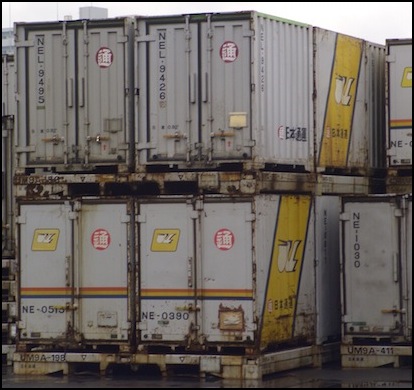
Nippon Express Containers on UM9A (2008)
Photographer: 5 1 6
References
Japanese Container Loading website.
Japanese website with photos and specifications of numerous containers.
Japanese Wikipedia pages for containers:
Japanese Wikipedia page for JR Cargo Container Format.
Japanese Wikipedia page for Container Business (lists specialty containers).
Older models: C10, C11, C12, C20, C21, C30, C31, C35, C36, C40, C95, NC1, ZC1.
Modern JR 12-foot Containers: 18A, 18B, 18C, 18D, 18E, 19A, 19B, 19C, 19D,
Ventilated: V18B.
20-foot JR: U5C, U30S, 30A, 30B, 30C, 30D
Open: UM11A, UM12A, UM13A, UM14C, UM20A
Other: 24A, M12B
Others: U45A, U54A, Z54A, U55A
Refrigerated: UF15A, UF42A, UF43A, UF46A, UF47A, UR48A, UR52A
Ventilated: UV51A, UV52A, UV54A
Tanks: UT24C, UT26C
Open: UM20A, UM30S
Platforms: UM9A




